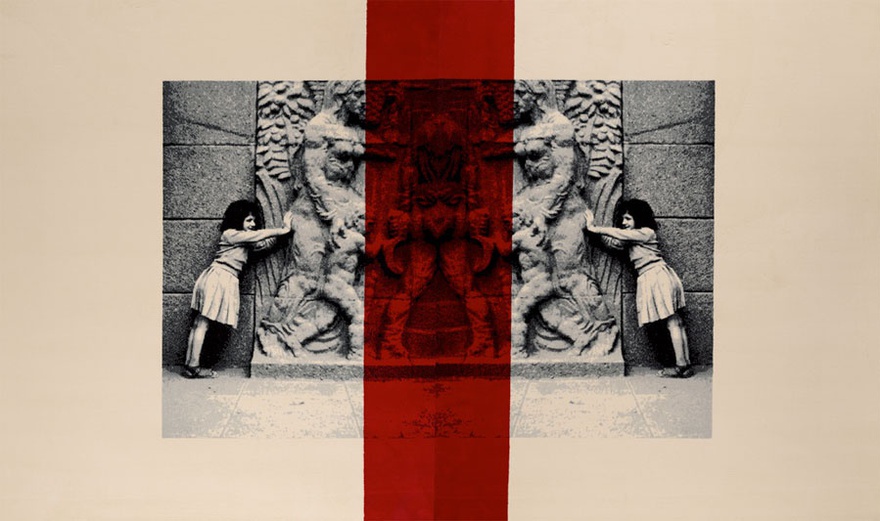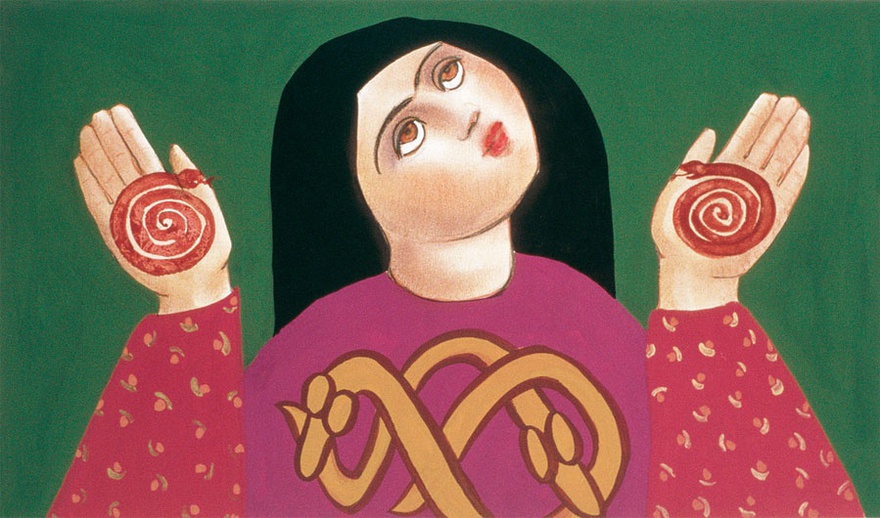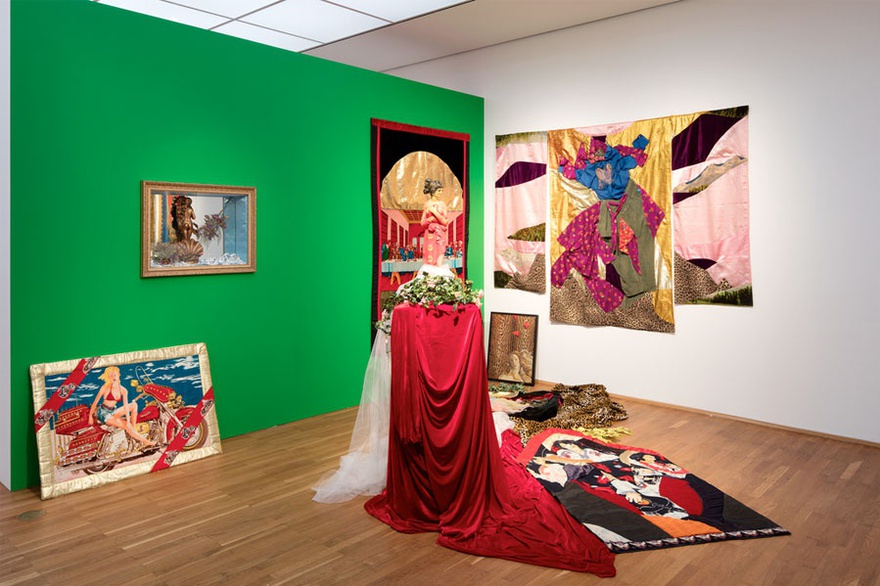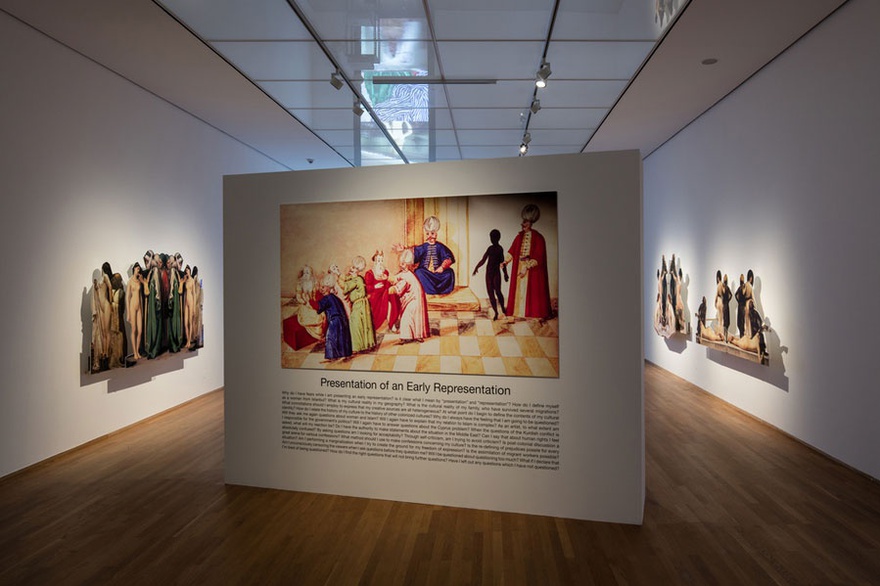Reviews
Chronographia
Gülsün Karamustafa Retrospective at Hamburger Bahnhof
As a child, the national anthem of Turkey reverberated in my ears for 11 years. Every Monday morning and Friday evening, we would line up perfectly in our school uniform to sing along with a forced nationalist pride. For some reason, the anthem was stuck in my head on the way to Gülsün Karamustafa's retrospective show Chronographia at Hamburger Bahnhof, which opened 10 June 2016. With 110 works dating back to the 1970s, from paintings, installations and videos, this thematic retrospective offers a multi-temporal, multi-layered insight into Karamustafa's practice, which has consistently dealt with the traumatic affects of nation building in Turkey.
The exhibition charts the history of modernization of Turkey through micro-stories Karamustafa has focused on throughout her practice. In Modernity Unveiled (2011), photos of happy men – students of the prominent Village Institutions, that trained teachers in the act of building at a construction site – are placed in between the frame of a wooden cube-like structure. The problematic vocabulary of a nation state, with particular gestures and repetitive performances is explored in the installation The Monument and the Child (2010), which includes a video showing a small girl – who seems to represent (to this writer at least) the future (mother) of the nation state – dancing to classical music. The absurd and colourful porcelain figures placed in front of her (including a female figurine with needles stuck to her green dress, reminiscent of voodoo dolls; an upside down angel placed on top of a cone; and a golden horse-head) deconstruct the typical objects found in upper class bourgeois Turkish houses. In a similar fashion, the work after which this exhibition takes its name, Chronographia (1994), consists of 60 issues of Radyo Haftası (Radio Week) – a magazine that Karamustafa's father wrote for regularly in the 1950s – stacked in circles, resembling a monument, and pointing to the bourgeois values of the time based on the postures of women and headlines of each front cover.
Problems occurred as a result of the politics of the nineteenth government and the Americanization of the 1950s in postwar Turkey. This led to the sociological and political confusion of the 1960s, as influenced by the leftist movements in May 1968. The country went through a significant change: besides the student clashes between right and left wing groups, economic problems led to large-scale migration from small villages to bigger cities, creating a hybrid city culture. Despite the traumatic effects of the 1960 and 1971 military coups, the leftist youth of the 1970s dreamed of a better future. In such a chaotic environment, Karamustafa was jailed for six months for concealing a political fugitive soon after her graduation from Academy of Fine Arts in Istanbul in 1969. The series Prison Paintings (1972) depict those years of imprisonment: women in vibrant reds, oranges, purples and blues are depicted sleeping in the prison dormitory, or waiting in line to get a bowl of soup. The video Making of The Wall (2003) documents some of the imprisoned women, recalling the days of torture and hunger strikes they experienced. The trauma is alleviated, yet certain memories remain present.
The history of Istanbul – with its Byzantine heritage of iconoclasm; its minorities that have, and continue to, shape the city; and the clichéd yet valid definition of being a bridge between East and West – resonates throughout Chronographia, and from various angles. Archaic female figures such as Virgo Orans and Venus come across in kitsch forms in works such as Against The Serpent (1986) or Gold Venus with Mirror (1985). Animal prints constantly appear in the works of the artist such as the textile-collage Tiger Woman (1983) or the video The City and The Secret Panther Fashion (2007). Icons from Christ to Elvis embellish the prayer rugs and the folded and crumpled glittery fabrics of Shield (1985) waver between mockery and a serious critique.
Moreover, Karamustafa reads history in unforeseen ways and reaches other temporalities, stretches time and manages to blend, for example, Byzantium figures with Arabesk elements of the 1980s to underline the problems of minorities. When it comes to LGBTQI members, for example, Turkish society tends to turn a deaf ear – which is reflected at the level of policy. Recently, authorities banned the Trans Pride march citing the threat of attacks by nationalists as the reason: of course, the march took place despite the verbal violence and the police fired tear gas to prevent the rally. The installation Kültür: A Gender Project From Istanbul (1996) addresses the problem of representation by displaying scenes on TV monitors from programmes featuring the famous diva Bülent Ersoy and the crossdresser Huysuz Virjin: representative of how transgender people are often perceived as some kind of spectacle, either as pop icons or prostitutes working in bad conditions. News from various resources reporting on the violence against transgender people are hung on the wall behind these screens, alongside a text written by the artist, titled A Playground in the Net of Gender Relations (1996), which explores the history of gender fluidity in the Ottoman Empire. Also addressed was the homosexual subculture around the national fire brigade, with volunteer firemen eroticized by both women and men, and the effects of three coup d'états (1960, 1971 and 1980) on this culture.
As this exhibition shows, women are undoubtedly Karamustafa's protagonists. In the 1960s and 1970s, newcomers to the city from villages, caught between traditional and modern values, generated a new aesthetic defined as Arabesk, which also gave its name to a music genre that addresses the pain and problems of the new class. Karamustafa dealt with the transformation of culture and its effects in works from the 1970s. In an interview she talks about the inspiration for the paintings such as The Lacemaker (1976) (the original title of the painting can be translated as The Covered Civilization – a better title, in my humble opinion) and Precious Bride (1975) in which she illustrates women who cover their electronic objects with lace, recalling a period of cultural ambiguity, during which, as Karamustafa has observed: 'the machine was being clothed, domesticized…'[1]
In the 1990s, the dissolution of the Soviet Union caused economic problems that led to a new trade market between some post-Soviet countries and Turkey. Women's bodies were also considered commodities for this cross-border trade, among other wares such as plastic flowers, make-up materials, colourful bras and cheap sunglasses. Objects of Desire/A Suitcase Trade (100-Dollar Limit) (1998) calls to mind this so-called 'suitcase trade' and consists of objects collected by the artist with the value of $100 – the rock bottom price of prostitution – from those markets. Formerly exhibited as part of the 4th Istanbul Biennial in the Antrepo Building in Galata (one of the oldest neighbourhoods hosting several brothels) NEWORIENTATION (1995) comprises pink and white ribbons – stamped with the initials of missing women and the dates that they were last seen by their families – tied to hooks once belonging to ships, recalling the human trade that has brought the lost protagonists to prostitution. Unfortunately, the impact of the piece was weakened in its relocation from its former position looking out at the Bosphorus. The piece is positioned on the small bridge of the Hamburger Bahnhof connecting two wings of the old train station; the audience gazes down at either Spree River or the minimalist Carl Andre sculptures located in the main hall of the museum. Recalling the uncanny death of Ana Mendieta, for which Andre has been suspected, it seems morbidly fitting that Andre's sculptures face Karamustafa's ribbons commemorating women who have disappeared.
Considering the problematic position of women in the art world, the staging of Chronographia at the prestigious Hamburger Bahnhof in Berlin holds certain significance. The museum's previous shows could be easily described as homages to the 'white male', which made this exhibition a pleasant surprise. Yet, as the piece Presentation of an Early Representation (1996) hints towards, I was also concerned as to how Gülsün Karamustafa would be represented and the possible orientalization that may occur. But the question had already been answered by the artist's description of the work:
…Is it clear what I mean by 'presentation' and 'representation'? How should I define myself as a woman from Istanbul? Will I again have to explain that my relationship to Islam is complex? As an artist to what extent am I responsible for the government's politics? Do I have the authority to make statements about the situation in the Middle East? What if I declare that I'm tired of being questioned?
Such questions strike the right note, with Karamustafa addressing the issue of representation by delving into the materiality of the objects she investigates, resulting in studies on complex issues that resonate beyond Turkey's borders.
Gülsün Karamustafa: Chronographia is on show at Hamburger Bahnhof, Berlin, until 23 October 2016.
[1] Selen Sarıoğlu. Günseli İnal, 'Sergisi Nedeniyle Gülsün Karamustafa Anlatıyor', Sanat Olayı, 5 May 1981: pp. 56-57.









